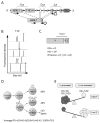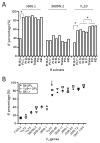Selection of individual VH genes occurs at the pro-B to pre-B cell transition
- PMID: 21746964
- PMCID: PMC3150439
- DOI: 10.4049/jimmunol.1100207
Selection of individual VH genes occurs at the pro-B to pre-B cell transition
Abstract
B cells are subjected to selection at multiple checkpoints during their development. The selection of Ab H chains is difficult to study because of the large diversity of the CDR3. To study the selection of individual Ab H chain V region genes (V(H)), we performed CDR3 spectratyping of ∼ 75-300 rearrangements per individual V(H) in C57BL6/J mice. We measured the fraction of rearrangements that were in-frame in B cell DNA. We demonstrate that individual V(H)s have different fractions of in-frame rearrangements (IF fractions) ranging from 10 to 90% and that these IF fractions are reproducible in different mice. For most V(H)s, the IF fraction in pro-B cells approximated 33% and then shifted to the nearly final (mature) B cell value by the cycling pre-B cell stage. The frequency of high in-frame (IF) V(H) usage increased in cycling pre-B cells compared with that in pro-B cells, whereas this did not occur for low IF V(H)s. The IF fraction did not shift as much in BCR-expressing B cells and was minimally affected by L chain usage for most V(H). High IF clan II/III V(H)s share more positively charged CDR2 sequences, whereas high IF clan I J558 CDR2 sequences are diverse. These data indicate that individual V(H)s are subjected to differential selection, that V(H) IF fraction is mainly established through pre-BCR-mediated selection, that it may operate differently in clan I versus II/III V(H)s, and that it has a lasting influence on the Ab repertoire.
Figures





Similar articles
-
The skewed heavy-chain repertoire in peritoneal B-1 cells is predetermined by the selection via pre-B cell receptor during B cell ontogeny in the fetal liver.Int Immunol. 2009 Jan;21(1):43-52. doi: 10.1093/intimm/dxn122. Epub 2008 Nov 14. Int Immunol. 2009. PMID: 19011159
-
The CDR-H3 repertoire from TdT-deficient adult bone marrow is a close, but not exact, homologue of the CDR-H3 repertoire from perinatal liver.J Immunol. 2010 Nov 15;185(10):6075-84. doi: 10.4049/jimmunol.1001419. Epub 2010 Oct 18. J Immunol. 2010. PMID: 20956348 Free PMC article.
-
Partial versus productive immunoglobulin heavy locus rearrangements in chronic lymphocytic leukemia: implications for B-cell receptor stereotypy.Mol Med. 2012 Feb 10;18(1):138-45. doi: 10.2119/molmed.2011.00216. Mol Med. 2012. PMID: 21968789 Free PMC article.
-
Repertoire selection by pre-B-cell receptors and B-cell receptors, and genetic control of B-cell development from immature to mature B cells.Immunol Rev. 2000 Jun;175:33-46. Immunol Rev. 2000. PMID: 10933589 Review.
-
BACH2-BCL6 balance regulates selection at the pre-B cell receptor checkpoint.Trends Immunol. 2014 Mar;35(3):131-7. doi: 10.1016/j.it.2013.11.002. Epub 2013 Dec 10. Trends Immunol. 2014. PMID: 24332591 Free PMC article. Review.
Cited by
-
The analysis of clonal expansions in normal and autoimmune B cell repertoires.Philos Trans R Soc Lond B Biol Sci. 2015 Sep 5;370(1676):20140239. doi: 10.1098/rstb.2014.0239. Philos Trans R Soc Lond B Biol Sci. 2015. PMID: 26194753 Free PMC article. Review.
-
Global analysis of B cell selection using an immunoglobulin light chain-mediated model of autoreactivity.J Exp Med. 2013 Jan 14;210(1):125-42. doi: 10.1084/jem.20120525. Epub 2012 Dec 24. J Exp Med. 2013. PMID: 23267014 Free PMC article.
-
Adaptive Immune Receptor Repertoire (AIRR) Community Guide to TR and IG Gene Annotation.Methods Mol Biol. 2022;2453:279-296. doi: 10.1007/978-1-0716-2115-8_16. Methods Mol Biol. 2022. PMID: 35622332 Free PMC article.
-
The restricted DH gene reading frame usage in the expressed human antibody repertoire is selected based upon its amino acid content.J Immunol. 2013 Jun 1;190(11):5567-77. doi: 10.4049/jimmunol.1201929. Epub 2013 Apr 29. J Immunol. 2013. PMID: 23630353 Free PMC article.
-
On being the right size: antibody repertoire formation in the mouse and human.Immunogenetics. 2018 Mar;70(3):143-158. doi: 10.1007/s00251-017-1049-8. Epub 2017 Dec 19. Immunogenetics. 2018. PMID: 29260260 Review.
References
-
- Tonegawa S. Somatic generation of antibody diversity. Nature. 1983;302:575–581. - PubMed
-
- Sakano H, Kurosawa Y, Weigert M, Tonegawa S. Identification and nucleotide sequence of a diversity DNA segment (D) of immunoglobulin heavy-chain genes. Nature. 1981;290:562–565. - PubMed
-
- Wardemann H, Yurasov S, Schaefer A, Young JW, Meffre E, Nussenzweig MC. Predominant autoantibody production by early human B cell precursors. Science. 2003;301:1374–1377. - PubMed
-
- Nemazee D. Receptor editing in lymphocyte development and central tolerance. Nat Rev Immunol. 2006;6:728–740. - PubMed
-
- Melchers F. The pre-B-cell receptor: selector of fitting immunoglobulin heavy chains for the B-cell repertoire. Nat Rev Immunol. 2005;5:578–584. - PubMed
Publication types
MeSH terms
Substances
Grants and funding
LinkOut - more resources
Full Text Sources
Miscellaneous

